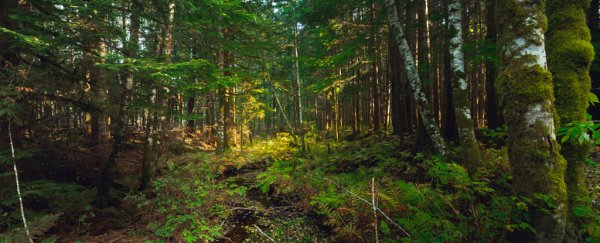The way humans manage the environment doesn't have to be destructive. In the western corner of Canada, ecologists have shown forests once tended by First Nations people are healthier and more resilient – even now, 150 years after these ancient custodians were forcibly displaced by colonial settlers.
The study is among the first to compare the Indigenous gardening practices of North America with modern-day land management, and the findings are stark.
In forests touched by recent human activity, researchers found a wood dominated by conifers and hemlocks. Whereas in the forest gardens of the Ts'msyen and Coast Salish peoples, the team found a diversity of native fruit and nut trees, including crabapple, hazelnut, cranberry, wild plum, and wild cherries.
In the gardens' undergrowth, they also noticed a spread of wild ginger and wild rice root.
"These plants never grow together in the wild. It seemed obvious that people put them there to grow all in one spot—like a garden," says ethnobiologist Chelsey Geralda Armstrong from Simon Fraser University in British Columbia.
"Elders and knowledge holders talk about perennial management all the time. It's no surprise these forest gardens continue to grow at archeological village sites that haven't yet been too severely disrupted by settler-colonial land-use."
It's generally accepted that agricultural practices in North America's Pacific Northwest arrived with the dawn of colonization, but that's simply not true.
Over the years, archaeologists have found extensive evidence of ancient forest gardens in this part of the world, and yet it's taken us until now to truly study the environmental impact of this millennia-long stewardship.
The first real research in British Columbia (BC) now suggests these gardens have helped build and benefit the ecosystem in ways that are still apparent today.
The study focuses on two Ts'msyen villages in northwestern BC and two Coast Salish complexes in southwestern BC, which were occupied until the late 1800s.
When the authors compared the ecological function of each site to its peripheral forests, they noticed the gardens produced significantly larger and more fertile seeds, had more shade-tolerant plants and were home to more insect-pollinated and animal-pollinated plants.
The forest gardens were also richer in plant species overall, with edible fruits making up 80 percent of that extra diversity.
The discovery suggests Canada's First Nations people were tending and translocating plants near their villages for food and medicine while also providing habitat for mammals like moose, bear, and deer, as they still do to this day.
"The forest gardens of Kitselas Canyon are a testament to the long-standing practice of Kitselas people shaping the landscape through stewardship and management," says Chris Apps, the director of lands and resources for the Kitselas First Nation.
"Studies such as this reconnect the community with historic resources and support integration of traditional approaches with contemporary land-use management while promoting exciting initiatives for food sovereignty and cultural reflection."
Nor is this just a lesson for the Pacific Northwest. Studies on Indigenous village sites and forest gardens in the Amazon, eastern Mexico, and northwestern Belize all suggest people once managed the environment for the better. Yet, these land-use legacies are rarely considered today by conservationists or ecologists.
"Although ecological studies rarely incorporate Indigenous land-use legacies, the positive effects of Indigenous land use on contemporary functional and taxonomic diversity that we observe provide some of the strongest evidence yet that Indigenous management practices are tied to ecosystem health and resilience," the authors conclude.
We should really try learning from this impressive legacy.
The study was published in Ecology and Society.
